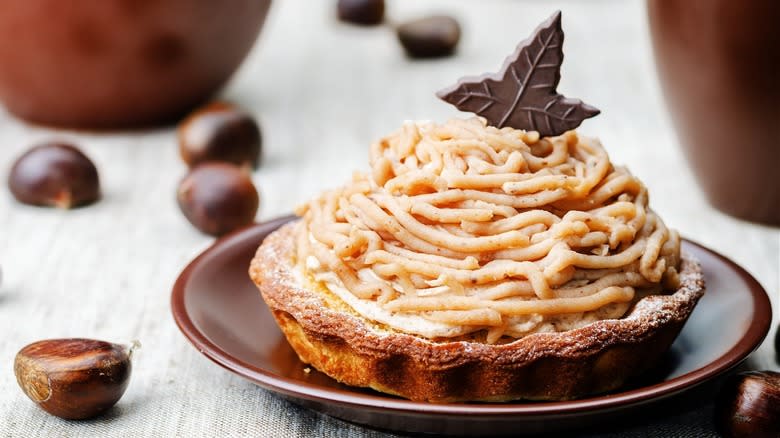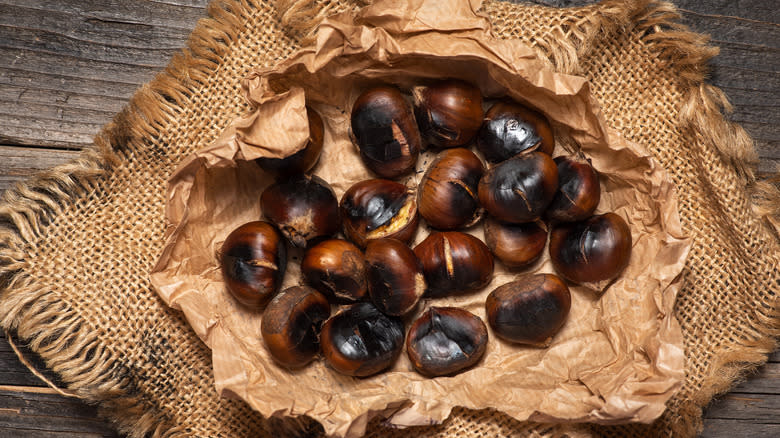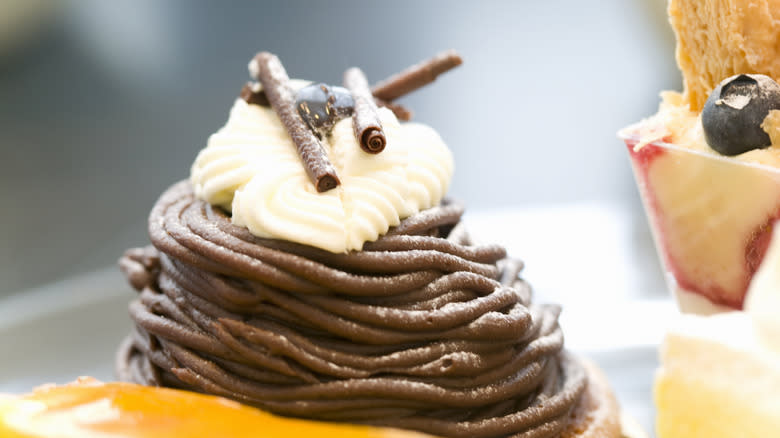Mont Blanc Dessert Is The French Sweet That Puts Chestnuts In The Spotlight

While those well-versed in European geography understand Mont Blanc to be the highest mountain peak in the Alps, foodies recognize mont blancs as decadent French pastries named after the monstrous, snow-capped mountain they are made to resemble. Despite being a wildly popular dessert in some regions of Europe and, perhaps surprisingly, Japan, mont blancs are largely unknown to the rest of the world. As such, the subtly sweet treats — crafted by piling strands of sweetened chestnut puree over a disc of meringue before topping the dessert with whipped cream and powdered sugar — remain one of France's best-kept secrets.
While the Italian and Japanese iterations may incorporate more inventive flavoring agents such as chocolate or bean paste, the delicious French recipe is uncomplicated, relying on the chestnuts' warm, nutty notes. The sweetness of sugar and vanillaaccentuates the dish's flavor even further. While the meringue simply acts as an airy vehicle for the caramel-like chestnut paste, the whipped cream adds a light creaminess to the ensemble.
Read more: 13 Store-Bought Ice Cream Bars Ranked From Worst To Best
A Little Bit Of This And Little Bit Of That

With three distinct elements required to make a mont blanc (including the meringue, the chestnut paste, and the whipped cream), a laundry list of ingredients goes into making the bite-sized pastries. Although they were traditionally crafted by piling the piped chestnut puree and cream directly on a plate, these days, French mont blancs are typically served atop a meringue. Chefs make the meringues by whipping room-temperature egg whites with salt, cream of tartar, sugar, and vanilla extract.
Because meringues require some cooking chops to pull off, homemade meringues can easily be substituted for pre-made meringue cookies in the making of a mont blanc. With the addition of heavy cream, several of the ingredients used to make the meringues including egg whites, sugar, and vanilla extract also go into the whipped cream that traditionally tops the mountain of chestnut puree
Unlike the Italian Monte Bianco, the chestnut puree in the French mont blanc is simply flavored, using just three pounds of raw chestnuts, water, sugar, and vanilla extract. A canned version can easily be substituted for the labor-intensive homemade variety but because the chestnut puree is the piece de resistance, most pastry chefs go the extra mile to make it from scratch.
Mont Blancs, Assemble!

Preparing mont blancs may be a laborious process but if done properly it is worth the effort. Because the meringue acts as the base of the dessert it is usually prepared first. Meringue is made by whipping egg whites with a hand mixer until the proteins unfold, creating a net around the air bubbles that form during the process. The sugar works to sweeten the mixture while also adding further stability to the bubbles, much like cream of tartar. While it's possible to make meringues without cream of tartar, the added stability it supplies to the egg whites significantly cuts down whipping time. Once the meringue is thick and peaking, it is piled into a pastry bag and then piped onto the parchment paper in 3-inch rounds to bake until hard and airy.
Making chestnut puree from scratch requires several steps as the chestnuts are typically raw and shelled to start. Before ever leaving their shell, the chestnuts must be scored and baked. Baking the chestnuts first not only adds flavor but also makes the removal of the shells significantly easier. The peeled chestnuts, sugar, and vanilla extract are then boiled together until tender before the whole ensemble is blended in a food processor. The resulting smooth paste is then transferred to a pastry bag and thinly piped onto the meringue in the shape of a bird's nest. To complete the treat, homemade whipped cream is scooped atop the nest of goodness and sprinkled with powdered sugar.
Where They Came From And Where They Are Now

While the origin of the mont blanc is somewhat hazy, several theories exist according to Yummy Bazaar. Some believe an early iteration of the dessert may have been developed in the Kingdom of Savoy during the Middle Ages while others think it was born in Italy around the same time as the Renaissance. The story most people stick with, however, is that the mont blanc was developed in a Parisian pastry shop, called Dessat in the middle of the 19th century.
Only served on a plate prior, the mont blanc received its modern makeover in 1903 when the Parisian bakeshop Angelina added meringue to the mix. It was the move that made the pastry shop famous. Angelina's mont blanc was so good that it is said to have inspired Japanese baker Chimao Sakota to bring it to his home country. There it became one of Japan's favorite sweets.
Whether it emanated from Italy or France, both countries have a worthwhile spin on the dish. While the French mont blanc is simply flavored and served on a plate or atop a meringue, the Italian version, called Monte Bianco, is deeper in flavor thanks to the addition of cocoa, fennel seeds, rum, and milk. The rich puree is typically served in a cup or piled on a cookie. Meanwhile, in Japan, inventive additions like bean paste and sweet potato are added to the puree before it is loaded onto a sponge cake base.
Read the original article on Mashed.

